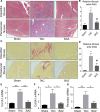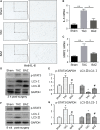Inhibition of Interleukin-6/glycoprotein 130 signalling by Bazedoxifene ameliorates cardiac remodelling in pressure overload mice
- PMID: 32164044
- PMCID: PMC7176848
- DOI: 10.1111/jcmm.15147
Inhibition of Interleukin-6/glycoprotein 130 signalling by Bazedoxifene ameliorates cardiac remodelling in pressure overload mice
Abstract
The role of IL-6 signalling in hypertensive heart disease and its sequelae is controversial. Our group demonstrated that Bazedoxifene suppressed IL-6/gp130 signalling in cancer cells but its effect on myocardial pathology induced by pressure overload is still unknown. We explored whether Bazedoxifene could confer benefits in wild-type C57BL/6J mice suffering from transverse aortic constriction (TAC) and the potential mechanisms in H9c2 myoblasts. Mice were randomized into three groups (Sham, TAC, TAC+Bazedoxifene, n = 10). Morphological and histological observations suggested TAC aggravated myocardial remodelling while long-term intake of Bazedoxifene (5 mg/kg, intragastric) attenuated pressure overload-induced pathology. Echocardiographic results indicated Bazedoxifene rescued cardiac function in part. We found Bazedoxifene decreased the mRNA expression of IL-6, MMP2, Col1A1, Col3A1 and periostin in murine hearts after 8-week surgery. By Western blot detection, we found Bazedoxifene exhibited an inhibition of STAT3 activation in mice three hours and 8 weeks after TAC. Acute TAC stress (3 hours) led to down-regulated ratio of LC3-Ⅱ/LC3-Ⅰ, while in mice after long-term (8 weeks) TAC this ratio becomes higher than that in Sham mice. Bazedoxifene inverted the autophagic alteration induced by TAC at both two time-points. In H9c2 myoblasts, Bazedoxifene suppressed the IL-6-induced STAT3 activation. Moreover, IL-6 reduced the ratio of LC3-Ⅱ/LC3-Ⅰ, promoted P62 expression but Bazedoxifene reversed both changes in H9c2 cells. Our data suggested Bazedoxifene inhibited IL-6/gp130 signalling and protected against cardiac remodelling together with function deterioration in TAC mice.
Keywords: Bazedoxifene; cardiac remodelling; interleukin-6; transverse aortic constriction.
© 2020 The Authors. Journal of Cellular and Molecular Medicine published by Foundation for Cellular and Molecular Medicine and John Wiley & Sons Ltd.
Conflict of interest statement
The authors confirm that there are no conflicts of interest.
Figures







Similar articles
-
Alleviation of Inflammation and Oxidative Stress in Pressure Overload-Induced Cardiac Remodeling and Heart Failure via IL-6/STAT3 Inhibition by Raloxifene.Oxid Med Cell Longev. 2021 Mar 20;2021:6699054. doi: 10.1155/2021/6699054. eCollection 2021. Oxid Med Cell Longev. 2021. Retraction in: Oxid Med Cell Longev. 2023 Dec 29;2023:9815047. doi: 10.1155/2023/9815047. PMID: 33824698 Free PMC article. Retracted.
-
Deletion of Interleukin-6 Attenuates Pressure Overload-Induced Left Ventricular Hypertrophy and Dysfunction.Circ Res. 2016 Jun 10;118(12):1918-1929. doi: 10.1161/CIRCRESAHA.116.308688. Epub 2016 Apr 28. Circ Res. 2016. PMID: 27126808 Free PMC article.
-
Repositioning Bazedoxifene as a novel IL-6/GP130 signaling antagonist for human rhabdomyosarcoma therapy.PLoS One. 2017 Jul 3;12(7):e0180297. doi: 10.1371/journal.pone.0180297. eCollection 2017. PLoS One. 2017. PMID: 28672024 Free PMC article.
-
Interleukin-10 treatment attenuates pressure overload-induced hypertrophic remodeling and improves heart function via signal transducers and activators of transcription 3-dependent inhibition of nuclear factor-κB.Circulation. 2012 Jul 24;126(4):418-29. doi: 10.1161/CIRCULATIONAHA.112.112185. Epub 2012 Jun 15. Circulation. 2012. PMID: 22705886 Free PMC article.
-
Inhibition of GP130/STAT3 and EMT by combined bazedoxifene and paclitaxel treatment in ovarian cancer.Oncol Rep. 2022 Mar;47(3):52. doi: 10.3892/or.2022.8263. Epub 2022 Jan 14. Oncol Rep. 2022. PMID: 35029286 Free PMC article.
Cited by
-
Endothelial Dysfunction and Diabetic Cardiomyopathy.Front Endocrinol (Lausanne). 2022 Apr 7;13:851941. doi: 10.3389/fendo.2022.851941. eCollection 2022. Front Endocrinol (Lausanne). 2022. PMID: 35464057 Free PMC article. Review.
-
Ursolic acid reduces oxidative stress injury to ameliorate experimental autoimmune myocarditis by activating Nrf2/HO-1 signaling pathway.Front Pharmacol. 2023 Jul 21;14:1189372. doi: 10.3389/fphar.2023.1189372. eCollection 2023. Front Pharmacol. 2023. PMID: 37547335 Free PMC article.
-
Systemic Action of Inflammatory Mediators in Patients with Essential Hypertension and Diastolic Chronic Heart Failure: A Clinical Pathophysiological Study.Pathophysiology. 2020 Dec 12;27(1):30-43. doi: 10.3390/pathophysiology27010005. Pathophysiology. 2020. PMID: 35366254 Free PMC article.
-
Bazedoxifene activates the angiotensin II-induced HUVEC hypertension model by targeting SIRT1.Exp Ther Med. 2022 Feb;23(2):120. doi: 10.3892/etm.2021.11043. Epub 2021 Dec 7. Exp Ther Med. 2022. PMID: 34970343 Free PMC article.
-
Nuclear Receptors in Myocardial and Cerebral Ischemia-Mechanisms of Action and Therapeutic Strategies.Int J Mol Sci. 2021 Nov 15;22(22):12326. doi: 10.3390/ijms222212326. Int J Mol Sci. 2021. PMID: 34830207 Free PMC article. Review.
References
Publication types
MeSH terms
Substances
LinkOut - more resources
Full Text Sources
Other Literature Sources
Medical
Miscellaneous

